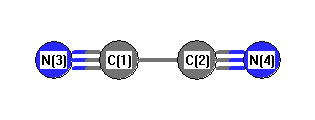Geometric Data

Point Group D∞h
Internal coordinates
distances (r) in Å, angles (a) in degrees, dihedrals (d) in degrees
Cartesians
| Atom |
x (Å) |
y (Å) |
z (Å) |
| C1 |
0.0000 |
0.0000 |
0.6950 |
| C2 |
0.0000 |
0.0000 |
-0.6950 |
| N3 |
0.0000 |
0.0000 |
1.8450 |
| N4 |
0.0000 |
0.0000 |
-1.8450 |
Atom - Atom Distances 
Distances in Å
| |
C1 |
C2 |
N3 |
N4 |
| C1 |
|
1.3900 | 1.1500 | 2.5400 |
| C2 |
1.3900 |
|
2.5400 | 1.1500 |
| N3 |
1.1500 | 2.5400 |
|
3.6900 |
| N4 |
2.5400 | 1.1500 | 3.6900 |
|
Calculated geometries
for C
2N
2 (Cyanogen).
Experimental Bond Angles (degrees) from cartesians 
| atom1 |
atom2 |
atom3 |
angle |
|
atom1 |
atom2 |
atom3 |
angle |
| C1 |
C2 |
N4 |
180.000 |
|
C2 |
C1 |
N3 |
180.000 |
Bond descriptions
Examples: C-C single bond, C=C, double bond, C#C triple bond, C:C aromatic bond
| Bond Type |
Count |
| C-C |
1 |
| C#N |
2 |
Connectivity
| Atom 1 |
Atom 2 |
| C1 |
C2 |
| C1 |
N3 |
| C2 |
N4 |












